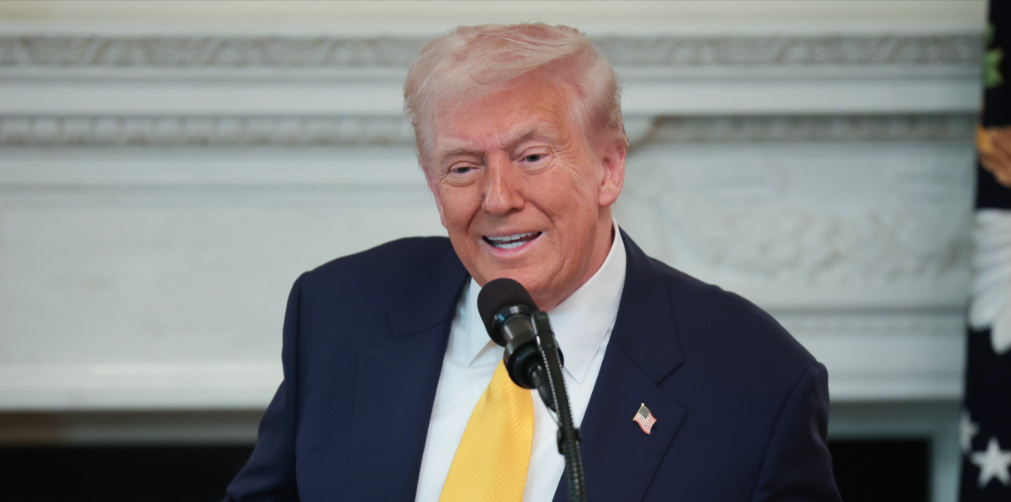Trump Announces Ft. Knox Trip To See If ‘Gold Is There’

Over the weekend, President Donald Trump took to social media to announce his intention to visit Fort Knox, Kentucky, to personally verify the presence of the gold reserves reportedly stored at the military base.
“We’re gonna go into Fort Knox to make sure the gold is there,” Trump stated in a video shared on X.
According to the U.S. Mint, the last time anyone outside of authorized personnel inspected a gold vault was in 1943, when President Franklin D. Roosevelt visited the Bullion Depository—a span of 82 years.
“You know that? We’re gonna go into Fort Knox. Do you know about that?” Trump remarked while addressing reporters, as captured in the clip posted online.
“One of the things we do want to look—I mean, we hope everything’s fine with Fort Knox, but we’re gonna go to Fort Knox, the fabled Fort Knox, to make sure the gold is there,” he elaborated.
A reporter then inquired, “Where would the gold have gone?”
“If the gold isn’t there, we’re gonna be very upset,” Trump responded.
.@POTUS: "We're going to go to Fort Knox — the fabled Fort Knox — to make sure the gold is there." pic.twitter.com/nFKlTDGXaO
— Rapid Response 47 (@RapidResponse47) February 20, 2025
As of Monday, the United States Bullion Repository reports that Fort Knox holds approximately 147.3 million ounces of gold, valued at around $435 billion. The market price of gold opened at $2,950.01 per ounce.
Since 1937, the United States Bullion Depository at Fort Knox has been responsible for safeguarding the nation's gold reserves, making it a symbol of security. Beyond storing gold, the base also houses the U.S. Army’s Human Resources Command Center and serves as the venue for the Army’s largest annual training event, as noted by the Economic Times.
“We’re going to open up the doors. We’re going to inspect Fort Knox,” Trump told Republican governors in a speech Thursday evening. “I don’t want to open it, and the cupboards are bare,” he added.
Located roughly 35 miles (56 km) south of Louisville, Fort Knox spans 109,000 acres and extends across three Kentucky counties: Bullitt, Hardin, and Meade.
Initially established during World War I as Camp Knox, the site functioned as an artillery training center, according to the Army post’s official records. It was designated a permanent installation in 1932 and has been known as Fort Knox ever since.
The facility received its first gold shipment in 1937, with the 1st Cavalry Regiment assigned to protect the highly secure transport.
During World War II, the Army designated Fort Knox as the headquarters for the Armored Force, where thousands of soldiers underwent training in tank warfare. For nearly eight decades, it was widely recognized as the “Home of Cavalry and Armor.”
According to the U.S. Mint, small amounts of gold have occasionally been removed for routine purity tests. Aside from these inspections, no significant transfers of gold have occurred in or out of the depository for many years.
Fort Knox remains one of the most heavily fortified locations in the world. Only a handful of individuals are aware of the vault’s complete security protocols, and no single person possesses full knowledge of the procedures required to gain access.
Public records indicate that the depository, built in 1936, incorporates 16,000 cubic feet of granite, 4,200 cubic yards of concrete, 750 tons of reinforcing steel, and 670 tons of structural steel. The facility is under constant protection, and throughout its history, it has only made rare exceptions to its strict no-visitors policy.
In 1974, amid ongoing speculation about the vault's contents, the U.S. Mint allowed a select group of journalists and a congressional delegation to inspect the gold reserves. The Treasury Secretary at the time approved the visit to dispel rumors that the gold had been removed.
The only other known instance of outsiders touring the vault occurred in 2017, when Treasury Secretary Steve Mnuchin, Kentucky Governor Matt Bevin, and several congressional representatives were granted access.
Current Treasury Secretary Scott Bessent has expressed willingness to facilitate an inspection for any senator interested in viewing the vault, as reported by the Economic Times.